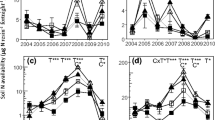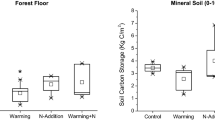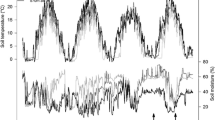Abstract
Background and aims
Climate warming and atmospheric nitrogen deposition are both expected to exert strong influences on soil organic matter in northern temperate ecosystems over the next century, but it is unclear to what extent these effects may be revealed by short-term field experiments. We compared the short-term (1–2 year) versus long-term (14–15 year) effects of nitrogen and warming on soil organic matter, while controlling for the effects of interannual environmental variability.
Methods
We added the new nitrogen addition and warming plots (short-term) to a pre-existing nitrogen and warming field experiment (long-term) in a grass-dominated field. We used soil density fractionation and size fractionation to separate the soil organic matter into the fine free light fraction, the coarse free light fraction and the occluded light fraction. We analyzed the quality of each soil organic matter fraction using Fourier-transform infrared (FTIR) spectroscopy.
Results
While the free light fraction decreased by 14% with nitrogen addition in the short-term plots, contrary to our prediction, it increased by 12% in the long-term plots. Likewise, in the long-term plots, the occluded light fraction increased by 58% with nitrogen addition when combined with warming. Organic matter quality generally did not differ among treatments for the different density and size fractions.
Conclusion
Our results demonstrate a divergence in the directions of long-term nitrogen addition and warming responses of soil organic matter fractions from those of short-term responses.





Similar content being viewed by others
Data availability
The datasets generated during and/or analysed during the current study are available from the corresponding author on reasonable request.
References
Bell TH, Klironomos JN, Henry HA (2010) Seasonal responses of extracellular enzyme activity and microbial biomass to warming and nitrogen addition. Soil Sci Soc Am J 74:820–828
Boeriu CG, Bravo D, Gosselink RJ, van Dam JE (2004) Characterisation of structure-dependent functional properties of lignin with infrared spectroscopy. Ind Crop Prod 20:205–218
Bradford MA, Wieder WR, Bonan GB, Fierer N, Raymond PA, Crowther TW (2016) Managing uncertainty in soil carbon feedbacks to climate change. Nat Clim Chang 6:751–758
Carreiro MM, Sinsabaugh RL, Repert DA, Parkhurst DF (2000) Microbial enzyme shifts explain litter decay responses to simulated nitrogen deposition. Ecology 81:2359–2365
Cenini VL, Fornara DA, McMullan G, Ternan N, Lajtha K, Crawley MJ (2015) Chronic nitrogen fertilization and carbon sequestration in grassland soils: evidence of a microbial enzyme link. Biogeochemistry 126:301–313
Cerli C, Celi L, Kalbitz K, Guggenberger G, Kaiser K (2012) Separation of light and heavy organic matter fractions in soil—testing for proper density cut off and dispersion level. Geoderma 170:403–416
Chen J, Luo YQ, van Groenigen KJ, Hungate BA, Cao JJ, Zhou XH, Wang RW (2018) A keystone microbial enzyme for nitrogen control of soil carbon storage. Science. Advances 4:eaaq1689
Craig BLH, Henry HAL (2022) Dominance by non-native grasses suppresses long-term shifts in plant species composition and productivity in response to global change. Oecologia 199:995–1005 https://doi.org/10.1007/s00442-022-05238-0
Galloway JN, Dentener FJ, Capone DG et al (2004) Nitrogen cycles: Past, present, and future. Biogeochemistry 70:153–226
Golchin A, Oades JM, Skjemstad JO, Clarke P (1994) Study of free and occluded particulate organic matter in soils by solid state 13C CP/MAS NMR spectroscopy and scanning electron microscopy. Aust J Soil Res 32:285–309
Guan S, An N, Zong N, He Y, Shi P, Zhang J, He N (2018) Climate warming impacts on soil organic carbon fractions and aggregate stability in a Tibetan alpine meadow. Soil Biol Biochem 116:224–236
Hagerty TP, Kingston MS (1992) The soils of Middlesex County. Ontario Ministry of Agriculture and Food
Harte J, Torn MS, Chang FR, Feifarek B, Kinzig AP, Shaw R, Shen K (1995) Global warming and soil microclimate: results from a meadow-warming experiment. Ecol Appl 5:132–150
Heckman K, Pries CEH, Lawrence CR, Rasmussen C, Crow SE, Hoyt AM, von Fromm SF, Shi Z, Stoner S, McGrath C, Beem-Miller J, Berhe AA, Blankinship JC, Keiluweit M, Marin-Spiotta E, Monroe JG, Plante AF, Schimel J, Sierra CA et al (2022) Beyond bulk: density fractions explain heterogeneity in global soil carbon abundance and persistence. Glob Chang Biol 28:1178–1196
Henry HAL, Juarez JD, Field CB, Vitousek PM (2005) Interactive effects of elevated CO2, N deposition and climate change on extracellular enzyme activity and soil density fractionation in a California annual grassland. Glob Chang Biol 11:1808–1815
Henry HAL, Hutchison JS, Kim MK, McWhirter BD (2015) Context matters for warming: interannual variation in grass biomass responses to 7 years of warming and N addition. Ecosystems 18:103–114
IPCC (2021) Climate Change 2021: The Physical Science Basis. Contribution of Working Group I to the Sixth Assessment Report of the Intergovernmental Panel on Climate Change [Masson-Delmotte V, P Zhai, A Pirani, SL Connors, C Péan, S Berger, N Caud, Y Chen, L Goldfarb, MI Gomis, M Huang, K Leitzell, E Lonnoy, JBR Matthews, TK Maycock, T Waterfield, O Yelekçi, R Yu, B Zhou (eds.)]. Cambridge University Press
James E (2020) Ground warming leads to changes in carbon cycling in northern fen peatlands: implications for carbon storage. Electronic Thesis and Dissertation Repository. 7360. https://ir.lib.uwo.ca/etd/7360
Jia J, Cao Z, Liu C et al (2019) Climate warming alters subsoil but not topsoil carbon dynamics in alpine grassland. Glob Chang Biol 25:4383–4393
Kazanski CE, Riggs CE, Reich PB, Hobbie SE (2019) Long-term nitrogen addition does not increase soil carbon storage or cycling across eight temperate forest and grassland sites on a sandy outwash plain. Ecosystems 22:1592–1605
Khalili B, Ogunseitan OA, Goulden ML, Allison SD (2016) Interactive effects of precipitation manipulation and nitrogen addition on soil properties in California grassland and shrubland. Appl Soil Ecol 107:144–153
Kölbl A, Kögel-Knabner I (2004) Content and composition of free and occluded particulate organic matter in a differently textured arable Cambisol as revealed by solid-state 13C NMR spectroscopy. J Plant Nutr Soil Sci 167:45–53
Komatsu KJ, Avolio ML, Lemoine NP et al (2019) Global change effects on plant communities are magnified by time and the number of global change factors imposed. Proc Natl Acad Sci 116:17867–17873
Li Y, Qing Y, Lyu M, Chen S, Yang Z, Lin C, Yang Y (2018) Effects of artificial warming on different soil organic carbon and nitrogen pools in a subtropical plantation. Soil Biol Biochem 124:161–167
Matějková Š, Šimon T (2012) Application of FTIR spectroscopy for evaluation of hydrophobic/hydrophilic organic components in arable soil. Plant Soil Environ 58:192–195
Melillo JM, Frey SD, DeAngelis KM (2017) Long-term pattern and magnitude of soil carbon feedback to the climate system in a warming world. Science 358:101–105
Niemeyer J, Chen Y, Bollag JM (1992) Characterization of humic acids, composts, and peat by diffuse reflectance Fourier-transform infrared spectroscopy. Soil Sci Soc Am J 56:135–140
Novick KA, Stoy PC, Katul GG, Ellsworth DS, Siqueira MBS, Juang J, Oren R (2004) Carbon dioxide and water vapor exchange in a warm temperate grassland. Oecologia 138:259–274
Parmesan C (2006) Ecological and evolutionary responses to recent climate change. Annual Review Ecology, Evolution, and Systematics 37:637–669
Peplau T, Schroeder J, Gregorich E, Poeplau C (2021) Long-term geothermal warming reduced stocks of carbon but not nitrogen in a subarctic forest soil. Glob Chang Biol 27:5341–5355
Riggs CE, Hobbie SE, Bach EM, Hofmockel KS, Kazanski CE (2015) Nitrogen addition changes grassland soil organic matter decomposition. Biogeochemistry 125:203–219
Rinnan R, Michelsen A, Bååth E, Jonasson S (2007) Fifteen years of climate change manipulations alter soil microbial communities in a subarctic heath ecosystem. Glob Chang Biol 13:28–39
Saiya-Cork KR, Sinsabaugh RL, Zak DR (2002) The effects of long-term nitrogen deposition on extracellular enzyme activity in an Acer saccharum forest soil. Soil Biol Biochem 34:1309–1315
Schnecker J, Borken W, Schindlbacher A, Wanek W (2016) Little effects on soil organic matter chemistry of density fractions after seven years of forest soil warming. Soil Biol Biochem 103:300–307
Sequeira CH, Alley MM, Jones BP (2011) Evaluation of potentially labile soil organic carbon and nitrogen fractionation procedures. Soil Biol Biochem 43:438–444
Six J, Carpentier A, van Kessel C, Merckx R, Harris D, Horwath WR, Lüscher A (2001) Impact of elevated CO2 on soil organic matter dynamics as related to changes in aggregate turnover and residue quality. Plant Soil 234:27–36
Song B, Niu S, Zhang Z, Yang H, Li L, Wan S (2012) Light and heavy fractions of soil organic matter in response to climate warming and increased precipitation in a temperate steppe. PLoS One 7:e33217
Song B, Niu S, Li L, Zhang L, Yu G (2014) Soil carbon fractions in grasslands respond differently to various levels of nitrogen enrichments. Plant Soil 384:401–412
Sun S, Wu Y, Zhang J et al (2019) Soil warming and nitrogen deposition alter soil respiration, microbial community structure and organic carbon composition in a coniferous forest on eastern Tibetan plateau. Geoderma 353:283–292
Tong X, Xu M, Wang X, Bhattacharyya R, Zhang W, Cong R (2014) Long-term fertilization effects on organic carbon fractions in a red soil of China. Catena 113:251–259
Turner MM, Henry HAL (2009) Interactive effects of warming and increased nitrogen deposition on 15N tracer retention in a temperate old field: seasonal trends. Glob Chang Biol 15:2885–2893
Wander M (2004) Soil organic matter fractions and their relevance to soil function. In: Magdoff F, Ray RW (eds) Soil organic matter in sustainable agriculture. CRC Press Inc., Boca Raton, pp 67–102
Wu Z, Dijkstra P, Koch GW, Hungate BA (2012) Biogeochemical and ecological feedbacks in grassland responses to warming. Nat Clim Chang 2:458–461
Zaccheo P, Cabassi G, Ricca G, Crippa L (2002) Decomposition of organic residues in soil: experimental technique and spectroscopic approach. Org Geochem 33:327–345
Funding
Research funding was provided to HALH via a Natural Sciences and Engineering Research Council of Canada Discovery Grant.
Author information
Authors and Affiliations
Contributions
All authors contributed to the study conception and design, data collection and analysis and, manuscript writing. All authors read and approved the final manuscript.
Corresponding author
Ethics declarations
Competing interests
The authors have no relevant financial or non-financial interests to disclose.
Additional information
Responsible Editor: Simon Jeffery.
Publisher’s note
Springer Nature remains neutral with regard to jurisdictional claims in published maps and institutional affiliations.
Rights and permissions
Springer Nature or its licensor (e.g. a society or other partner) holds exclusive rights to this article under a publishing agreement with the author(s) or other rightsholder(s); author self-archiving of the accepted manuscript version of this article is solely governed by the terms of such publishing agreement and applicable law.
About this article
Cite this article
Stroud, E., Henry, H.A.L. Contrasting short-term vs. long-term effects of warming and nitrogen addition on soil organic matter density fractions in a temperate grass-dominated system. Plant Soil 487, 407–417 (2023). https://doi.org/10.1007/s11104-023-05938-3
Received:
Accepted:
Published:
Issue Date:
DOI: https://doi.org/10.1007/s11104-023-05938-3




